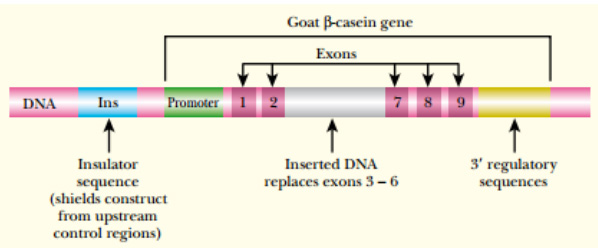The somatotropin gene from cows has been cloned and expressed in bacteria thus allowing the production of large amounts of the hormone, which is known as rBST (recombinant bovine somatotropin) . The rBST is used in the dairy industry to increase milk production. Unlike in mice, boosting an adult cow’s somatotropin levels by injection of extra hormone results in increased milk production, rather than giant cows. Milk from treated cows is now widely marketed.
At present, bacteria, such as Escherichia coli , are cultured to make most recombinant proteins, such as human insulin or somatotropin. Such products are expensive and require a highly trained work force. However, using livestock to express these products may be cheaper. Dairy cows produce 10,000 quarts of milk each per year, and an industry to collect and process milk already exists. To take advantage of this, several recombinant proteins are now being produced in the milk from transgenic cows or other farm animals. To achieve this, cloned genes are placed under the control of a regulatory region that will allow gene expression only in the mammary gland. Consequently, the gene product will come out in the milk. For small-scale production of proteins for clinical use, transgenic goats are often used. For example, transgenic goats have been made to produce recombinant tissue plasminogen activator (rTPA) , which is used for dissolving blood clots.

FIGURE :Milk Expression Construct for Transgenic Goats
In order to express a recombinant protein in goat milk, the gene of interest is inserted in place of the β -casein gene. The transgene will be expressed using the endogenous promoter and 3′ regulatory elements that restrict β -casein expression to goat milk. The construct also has
insulator sequences that block other regulatory elements from affecting expression (see later
discussion).